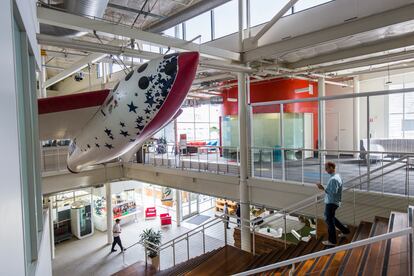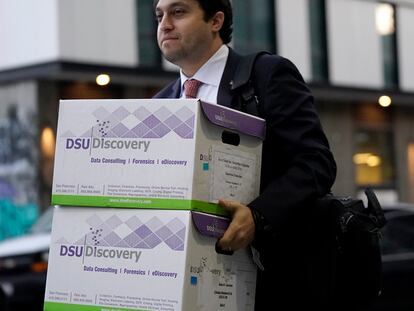Tech giants announce record layoffs after hiring binge
Amazon, Alphabet, Microsoft, Meta and Apple nearly doubled their total workforce over the past three years. But now they are letting more than 50,000 employees go


The wave of tens of thousands of layoffs at big tech companies is, to a large extent, the result of a miscalculation.
The same companies that are now announcing – with rueful messages – that they are laying off many of their workers only recently were hiring new employees at an unprecedented rate.
Amazon, Alphabet (Google), Microsoft, Meta and Apple – five giants of big tech – increased their payroll by a total of one million people over the last three years. But now, these firms have dismissed a total of more than 50,000 workers. The only giant not to have announced major layoffs is Apple.
“We hired for a different economic reality than the one we face today,” Sundar Pichai – the CEO of Google – acknowledged in his message to staff, when he announced that the company is cutting 12,000 jobs.
It’s true that the economic situation has deteriorated, but the labor market in the United States is more vigorous than ever, with an unemployment rate of only 3.5% – one of the lowest recorded over the past 50 years.
The “economic reality” has changed in the sense that the strong demand for products and services offered by technology companies – which peaked during pandemic lockdowns – has calmed down. Consumer habits have returned to more normal levels, while widespread teleworking has declined. Technology companies find themselves earning revenues that no longer grow at the rate they expected, while costs have risen. For some of these giants, profits have fallen sharply.
The battle to hire engineers, technicians and programmers in Silicon Valley had also caused salaries to skyrocket. For those who are losing their jobs, the problem is that now, all the companies seem to be laying people off at the same time, making it more difficult to find an opening in the sector.
The case of each company is different. However, the common denominator is an unprecedented staff increase over the past few years. According to figures consulted by EL PAÍS – from the annual and quarterly reports of these companies – the five technology giants went from having 926,000 employees in 2017 to more than two million in 2022.
These figures are highly affected by the expansion of Amazon, which had 566,000 workers in 2017; 798,000, at the end of 2019, just before the pandemic; and closed 2021 with 1,608,000 employees. The latest figure published by the company is 1,544,000 workers as of September 30, 2022, but given the seasonality of the company – with more temporary workers being hired during holidays – this figure still represented a year-over-year increase of 76,000 jobs. The 18,000 layoffs announced by Amazon represent just over 1% of its workforce, although they still represent the largest workforce cut in the history of tech companies.
The case of the firm founded by Jeff Bezos is peculiar. Amazon’s employment profile is quite different from the other four firms – many of its staff aren’t technology experts, but rather, are logistics workers. Plus, the company has undertaken a major international expansion in recent years. That being said, the hiring fever also occurred throughout the rest of the tech sector.
Meta was the first to announce layoffs, with a cut of 11,000 jobs. But the company founded and run by Mark Zuckerberg had increased its payroll from 25,000 workers in 2017 to 87,314 by the third quarter of 2022. The number of employees practically doubled since the start of the pandemic, when 45,000 people were working at Meta.
Alphabet – the parent company of Google – has more than doubled its workforce in the last five years, from 88,000 employees in 2017 to 186,779 as of September 30, 2022. Hiring also accelerated during the pandemic, as the company added 68,000 positions from the end of 2019. Now, the company has announced 12,000 layoffs, representing 6% of its total workforce.
Microsoft has also increased its payroll by 77,000 people in three years and by 97,000 since 2017, to reach 221,000 by the end of the last fiscal quarter. The company – founded by Bill Gates and run by Satya Nadella – has announced a cut of 10,000 jobs, or 5% of its workforce.
Apple is the only one of the Big Five tech giants that hasn’t announced mass layoffs. Hiring has been reined in – some recruiters have been dismissed and there have been minor adjustments across the board – but it hasn’t engaged in the record-high cuts of the other four organizations.
Of the top tech CEOs, Apple’s Tim Cook has been the most restrained in terms of hiring. The workforce has increased in the last three years by 27,000 people, closing the 2022 fiscal year with 164,000 employees. Although this represents a not inconsiderable increase of 20%, it is far from the recent hiring increases at Microsoft, Alphabet, Meta and Amazon – 53%, 57%, 84% and over 100% respectively.
The big five tech companies have almost doubled their workforce in three years. A small part of that increase has been from the acquisition of other companies. Top executives at the tech giants have admitted that this acceleration in hiring – along with a slowdown in economic growth and a reduction in demand for their products and services – has stifled them.
“This year’s outlook has been more difficult, given the uncertainty of the economy and [the fact] that we have hired quickly in recent years,” begins the message in which Andy Jassy – Amazon’s CEO – announces the impending workforce cut.
“Just as we saw customers accelerate their digital spending during the pandemic, we’re now seeing them optimize their digital spending to do more with less,” admitted Microsoft’s Satya Nadella.
Mark Zuckerberg is someone who has voiced a more cohesive mea culpa:
“At the beginning of COVID, the increase in e-commerce led to an enormous growth in revenue. Many people predicted that this permanent acceleration would continue even after the pandemic ended. I did too, so I made the decision to significantly increase our investments. Unfortunately, this did not go as expected,” said the founder and CEO of Meta in a message to his staff. “I was wrong and I take responsibility for it.”
Sign up for our weekly newsletter to get more English-language news coverage from EL PAÍS USA Edition
Tu suscripción se está usando en otro dispositivo
¿Quieres añadir otro usuario a tu suscripción?
Si continúas leyendo en este dispositivo, no se podrá leer en el otro.
FlechaTu suscripción se está usando en otro dispositivo y solo puedes acceder a EL PAÍS desde un dispositivo a la vez.
Si quieres compartir tu cuenta, cambia tu suscripción a la modalidad Premium, así podrás añadir otro usuario. Cada uno accederá con su propia cuenta de email, lo que os permitirá personalizar vuestra experiencia en EL PAÍS.
¿Tienes una suscripción de empresa? Accede aquí para contratar más cuentas.
En el caso de no saber quién está usando tu cuenta, te recomendamos cambiar tu contraseña aquí.
Si decides continuar compartiendo tu cuenta, este mensaje se mostrará en tu dispositivo y en el de la otra persona que está usando tu cuenta de forma indefinida, afectando a tu experiencia de lectura. Puedes consultar aquí los términos y condiciones de la suscripción digital.
More information
Archived In
Últimas noticias
Most viewed
- Reinhard Genzel, Nobel laureate in physics: ‘One-minute videos will never give you the truth’
- Oona Chaplin: ‘I told James Cameron that I was living in a treehouse and starting a permaculture project with a friend’
- Pablo Escobar’s hippos: A serious environmental problem, 40 years on
- Charles Dubouloz, mountaineering star, retires at 36 with a farewell tour inspired by Walter Bonatti
- Why we lost the habit of sleeping in two segments and how that changed our sense of time










































